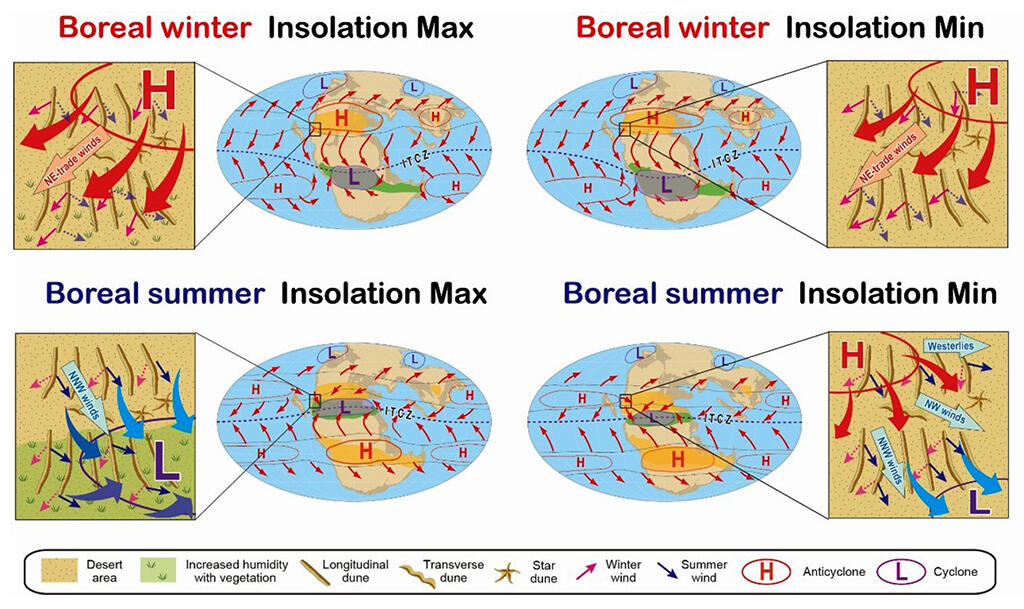A research group led by graduate student Hiroki Shozaki of the Department of Earth and Planetary Sciences, Graduate School of Science at Tokyo Institute of Technology, and lecturer Hitoshi Hasegawa of the Natural Science Cluster of the Faculty of Science and Technology at Kochi University has studied a 200-million-year-old desert stratum widely distributed in the Midwestern United States and unraveled the mystery of atmospheric circulation of the supercontinent Pangaea.

Shozaki et. al. Development of longitudinal dunes under Pangaean atmospheric circulation. DOI: 10.5194/cp-18-1529-2022. (CC by 4.0)
The supercontinent Pangaea, a single mass of all the continents of the Earth, existed about 200 to 300 million years ago. Atmospheric circulation and surface wind patterns are thought to have been very different during this period because the difference in the heat capacity of the land and ocean was greater than today. However, the kind of atmospheric circulation that developed during this period has been a great mystery because the results of reproductions of surface wind patterns with climate model simulations and the results of reconstructions from desert strata (aeolian dunes) that serve as a record of past wind patterns did not match.
To reconstruct the surface wind patterns of the supercontinent Pangaea, the study focused on the direction of sedimentary structures and large oblique stratigraphic structures in the strata of aeolian dunes. Large oblique stratigraphic structures are formed when sand grains carried by the wind are deposited on the front surface of a dune. By measuring the direction of large oblique stratigraphic structures preserved in a formation, it is possible to estimate the wind direction and dune morphology of the location at the time when the formation was created.
The research group conducted surveys in seven Midwestern U.S. states (Utah, Nevada, Arizona, New Mexico, Colorado, Idaho and Wyoming) over a total distance of approximately 20,000 km over a three-year period from 2017-19 to measure the orientation of large oblique strata in the strata of aeolian dunes spread over a wide area across the deserts of Pangea. Their results show that westerlies, north-westerlies and north-easterly winds were widespread in the deserts in this region about 200 million years ago. The three-way wind pattern was found to be in good agreement with the surface wind patterns in a climate model reproduction, recording prevailing north-westerly winds in summer and prevailing westerly and north-easterly trade winds in winter.
In addition to their broad survey of the Midwestern United States, the group also conducted detailed studies of strata and examined dune morphology in places such as Zion National Park in Utah. In Zion National Park, this sedimentary boundary surface developed about every three to four meters. Based on the age of Navajo Sandstone data reported in earlier studies, this interval of about three to four meters is approximately 60,000-200,000 years old. In other words, changes in wind patterns and dry-wet environments were recorded with a cycle like that of the approximately 100,000-year cycle of eccentricity variations. This was consistent with the reproduced results from climate model simulations, which revealed the influence of the Earth's orbital element variations during the Pangaea era on the development of longitudinal dunes.
The results of this research are expected to help identify what kind of climate and environment prevailed at each latitude under the peculiar atmospheric circulation of Pangaea. Since aeolian dunes are also found on the surfaces of other planets (Mars and Venus) and moons (Titan, Saturn's moon), the researchers believe that by applying their findings, they can demystify the atmospheric circulation patterns on ancient Mars, where supercontinents and superoceans once existed, and solve the mystery of how the dunes on Titan formed in the subsurface structure.
■ Aeolian dunes: Sand dunes that develop in desert environments. They have various shapes such as crescent, transverse and longitudinal dunes. The presence of wind-shaped dune strata indicates that a desert existed in that location in the past. Since the dunes advance while creating a frontal plane on the downwind side during deposition, forming large oblique strata in the ground, it is possible to reconstruct the past wind direction from the direction of the large oblique strata in the strata.
Journal Information
Publication: Climate of the Past
Title: Development of longitudinal dunes under Pangaean atmospheric circulation
DOI: 10.5194/cp-18-1529-2022
This article has been translated by JST with permission from The Science News Ltd.(https://sci-news.co.jp/). Unauthorized reproduction of the article and photographs is prohibited.




